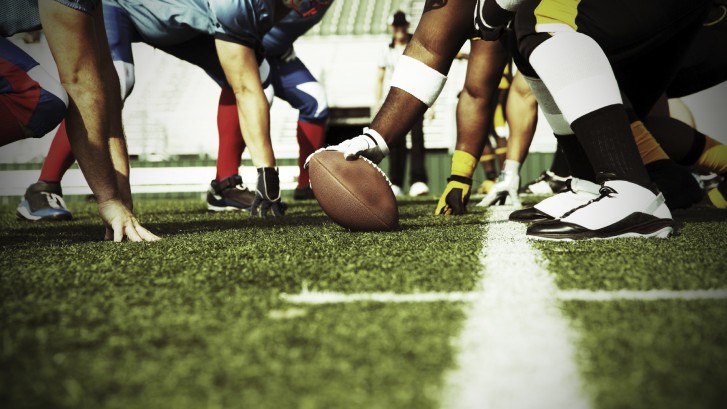Making Contact
Injuries are inevitable in contact sports. The lower extremities — an athlete’s steering, accelerator, and braking systems– are particularly susceptible. But with proper conditioning, equipment, and technique, competitors in contact sports have successful, healthy playing seasons.
Podiatric physicians, specialists in care of the lower extremity, not only treat injuries athletes and get them back into competition as soon as safely possible, but also help athletes get into a condition that minimizes their risk of injury to the foot and ankle.
Preventing “Overuse” Injuries
The time a football, soccer, or lacrosse player spends in an actual game represents only a tiny fraction of time spent in practice, conditioning for competition. Practice involves hours of running, repetitive drills, and scrimmages every day.
While conditioning exercises in practice will strengthen and improve flexibility in the lower extremity, the repeated stress of practice may bring on chronic, or “overuse” injuries. These injuries can nag at a player and hamper, if not end, a season of competition.
Overuse injuries also come from faulty biomechanics of the feet — how the lower extremity physically adjusts to the ground. If an athlete has “flat” feet, which tend to pronate (out-toe) or excessively high arches, which often supinate (in-toe), extensive running and cutting can produce chronically strained ankles.
Before taking the practice field, it’s wise to be examined by a podiatric physician specializing in sports medicine, who will identify any biomechanical abnormalities that increase the chance of injury. The podiatrist may recommend specific exercises to strengthen and improve flexibility of the foot and ankle, or recommend taping or padding of the foot or ankle before practice and competition. A podiatrist may also prescribe orthoses, customized shoe inserts that correct biomechanical problems by redistributing the body’s weight.
Podiatric physicians say proper stretching and warmup before and after home workouts, practice, and before games go far to prevent overuse injuries to the supporting structures of the lower extremity. Warm-up and cool-down exercises should take 5-10 minutes and should be conducted in a stretch/hold/relax pattern, without any bouncing or pulling. When muscles are properly warmed up, the strain on muscles, tendons, and joints is reduced.
Crashes, Bumps, and Bruises
The foot and ankle bear the brunt of the crashes, bumps, and bruises of contacts sports. Feet get stepped on, kicked, jammed, twisted, and cut. Quick changes in direction and hard tackling can lead to sprains and fractures of the ankle.
Impact, or trauma injuries are more serious than overuse injuries and require recovery time away from the practice and game field. Immediate treatment should include the “RICE” formula: Rest, Ice, Compression, and Elevation.
Trauma injuries should always be treated by a medical professional such as a podiatrist and be fully healed before returning to the field. Players who lie about how an injury feels, or take pain-killers to play through a trauma injury, are not helping their team by doing so but rather putting themselves in danger of aggravated or permanent injury.
Footwear
Cleats are the footwear of choice for all contacts sports down to the youth leagues. Cleats are generally safe for young ankles, say podiatrists. Cleats should be light, flexible, and always fit properly. Uppers should be supple (no hand-me-downs, please), and there should be at least a finger’s width separating the tip of the big toe and the end of the shoe. Laces should be tight.
When shopping for cleats, wear the same style of socks you intend to wear in competition. Shop in the afternoon, when the feet are naturally slightly swollen. Investing in proper footwear for a young athlete is much less expensive than medical treatment later.
Artificial Turf
Contact sports are sometimes played on artificial turf, which presents a new set of concerns for an athlete. Some surfaces simulate the texture of grass, and others are little more than carpet. All forms of artificial surface are harder than grass and make for speeded-up competition. Cross-training shoes or sneakers are the footwear of choice on artificial turf.
Because the surfaces do not “give” like grass, playing on them may be more hazardous to the lower extremity. Players should be well-familiarized with the dynamics of running and changing direction on “turf” before competing on that surface.
Trainers and physicians frequently tape the feet and ankles of their players for added stability, especially on artificial turf. Proper taping can help prevent injuries from occurring and keep a minor injury from becoming a major one.
Injuries and Treatments
Keeping the lower extremity healthy is so important to an athlete that most all professional football and soccer teams have a team podiatrist who treats minor problems like corns, calluses, and blisters, and major injuries like fractures and dislocations. The following are the most common injuries suffered in contact sports:
Ankle Sprains: Making contact on a firmly planted ankle can forcibly invert the joint and damage ligaments, resulting in a sprain. Immediate treatment using the RICE formula to reduce swelling is important to quick healing. Any sprain that doesn’t show improvement in three days should be checked by a podiatric or family physician.
Ankle Fractures : Fractures are more serious injuries that require immediate medical attention. Casting and sometimes surgery is required to immobilize fractures and set breaks. Requiring 10-12 weeks for rehabilitation, a fracture or a break essentially ends a season of competition in any contact sport.
Stress Fractures: There are two distinct kinds of fractures that require vastly different treatment. Stress fractures are incomplete cracks in bone caused by overuse. Stress fractures heal with complete rest. Extra padding in shoes helps prevent them.
Turf Toe: Turf toe is a painful jam or hyperextension of the big toe. The condition is more common on artificial turf but can happen on grass as well. Immediate treatment includes the RICE regimen, and wearing a stiffer shoe prevents aggravation of the injury. Splinting the toe or special orthoses can also help.
Contact Sports Tips
- Pay attention to injury. Don’t play hurt.
- Don’t let children use running shoes for contact sports. Wear sport specific shoes.
- Warm up properly. Condition yourself safely in the off season.


